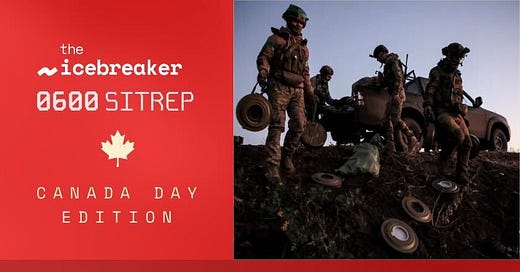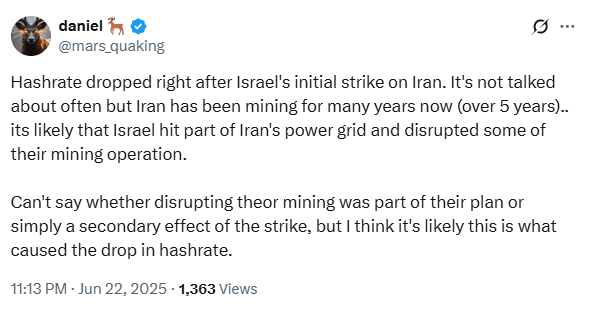🎯 Three-Shot Burst
Ukraine withdraws from anti-landmine treaty
Ukraine’s President on Sunday signed a decree putting his war-torn country on track to leave an international anti-landmine treaty signed in Ottawa in 1997.
The Ottawa Convention bans signatories from acquiring, producing, stockpiling or using anti-personnel mines, which are designed to be buried or hidden on the ground. They often leave victims mutilated if they are not immediately killed, and unexploded mines cause long-term risks for civilians. The move follows similar decisions by Kyiv’s allies Poland, Finland, Lithuania, Latvia and Estonia -- all neighbours of Russia.
Asymmetric advantage: Russia's use of anti-personnel mines has been called ‘an asymmetric advantage' by Ukrainian officials. "This is a step that the reality of war has long demanded. Russia is not a party to this Convention and is massively using mines against our military and civilians," said Roman Kostenko, secretary of the Ukrainian parliament's committee on national security, defence and intelligence. “We cannot remain tied down in an environment where the enemy has no restrictions”.
Business speak: Leave it to a Silicon Valley bro to make this gruesome reality all about callous market-sizing:
Bottom line: Modern alternatives like smart mines, remotely controlled barriers or advanced surveillance aren’t mature or scalable enough to replace the brute effectiveness of traditional anti-personnel landmines in large-scale, high intensity warfare. Ukraine’s pivot signals that, when the stakes are existential, militaries will default to proven, if ugly, tools unless new tech can deliver equivalent battlefield impact at scale and speed.
Related:
‘Hero of Ukraine’ commander develops drone-proof uniforms
Ukraine is inching towards robot-on-robot fighting
📋 Arctic Waters
Canada’s first Defence Tech Hackathon - September 20 in Toronto
Our community asked, and this Canada Day, we answered:
The Icebreaker, in partnership with Build Canada and NordSpace, is excited to announce Canada’s first defence tech hackathon.
The Defence Tech Hackathon is a catalyst to jumpstart a world-class ecosystem that builds sovereign capability in Canada. Our goal is to attract top talent, rapidly prototype real-world solutions, and bridge the gap between innovators and military end-users.
By forging new startups, building critical networks, and injecting a sense of urgency into defence innovation, this hackathon lays the foundation for Canada to compete and win on the global stage. We aim to advance the grassroots spirit of current and soon-to-be defence tech entrepreneurs.
We are still finalizing details, but here is what we know so far:
We will aim to rapidly prototype dual-use tech that solves real operational gaps for the Canadian Armed Forces
We are considering a challenge for a prototype platform that ingests multi-modal sensor feeds (satellite, UAV, radar, acoustic, etc.) and fuses them for real-time Arctic domain awareness
If you’re a software engineer who is defence-curious, this could be for you. We are looking for folks with domain expertise/experience in one or more of: defence, dual use tech (software and technology that can be used for both civilian and military applications), or Arctic operations; or who have any prior experience with multi-modal sensor fusion and real-time data platforms
🛥️ Happy Canada Day
In 2017, 444 Canadians sailed 25,000 km along the world’s longest coastline for Canada’s 150th anniversary of Confederation. Friend of the Newsletter Ryan Rizzo, CEO of TerreSky, was aboard, and took this drone footage as he sailed the Northwest Passage:
Happy 158th, Canada!
⚔️ Combat Readiness
Bunker Busting
The June 22 mission to destroy Iran’s nuclear facilities had been in contingency planning and rehearsal for many years, and included assets from below the waves to space.
Photo credit: our pals at Defense Tech and Acquisition.
Related:
Canada has much to learn from the Israel-Iran war as we boost defence spending
What Shipbuilding in Ashbridges Bay can teach us about the current moment for Canada
Bitcoin hash rate falls after United States struck nuclear facilities inside Iran:
🍁 Canada’s Inaugural Defence Power 50 List
The Icebreaker is excited to announce the opening of nominations for Canada’s inaugural Defence Power 50 List. The list will recognize the most influential leaders and up-and-comers in the defence community who are critical to making the changes Canada needs.
The selection of this inaugural 2025 list is co-chaired by Erin O'Toole, Glenn Cowan, Philippe Lagassé, Sheldon McCormick, and Eliot Pence.
Bottom Line: Nominate someone we should know about today!
👂 We hear you!
In Friday’s newsletter, we talked about the difficulty that defence companies sometimes encounter accessing banking services. Several community members wrote to us about just such issues in Canada.
Down south: Last week, in the US, the Federal Reserve announced it was directing its supervisors to no longer consider "reputational risk" when examining banks, scrapping a metric that had been a focus of industry complaints.
Bottom line: American banks can no longer turn away customers because of the industry they are in. Reputational risk used to be an acceptable reason to deny business. That is now out as a criterion.
Here in Canada, our pal Kevin Reed has a few ideas for how to solve this…
✍️ First person POV
Kevin Reed, President of the new Defence, Security and Resilience Bank, who joined The Icebreaker for a panel last week in Toronto, with a perspective on what the new NATO 5% target means for Canada:
Canada’s Defence Spending Set to Triple Amid NATO Commitments
“It was the easiest war to prevent by timely collective action”
Winston Churchill, The Gathering Storm (1948)
At the recent annual NATO summit in The Hague, member nations reached a near-unanimous agreement on a significant increase in defence spending. Each country is now expected to elevate its defence budget from the current target of 2% to 5% of GDP by 2035.
For Canada, this shift represents a dramatic increase. Based on current projections, defence spending would need to triple, surpassing $150 billion annually.
To understand the implications of this transformation, it’s worth looking back at a pivotal moment in Canada’s economic history. In 1939, on the eve of the Second World War, Canada’s GDP stood at $5.6 billion. By the end of the war in 1945, it had more than doubled to $11.8 billion. Over that six-year span, the economy expanded at an annual rate exceeding 13%, fundamentally reshaping the Canadian economic landscape.
This historical parallel underscores the scale of investment and transformation required in the years ahead.
To meet NATO’s ambitious target of 5%, Canada must fundamentally rewire its financial system to ensure defence-sector companies—particularly small and medium-sized enterprises (SMEs)—have access to the capital and credit necessary to grow, hire, and invest.
In Canada, starting or operating a defence-focused business remains exceptionally difficult—particularly for companies outside the small circle of major prime contractors. For most, access to financing is severely limited. Structural challenges such as long sales cycles, unpredictable cash flows, and reliance on fluctuating government budgets make defence firms unappealing to mainstreet lenders. Regulatory hurdles, including high barriers to entry and stringent compliance requirements, further complicate the picture. On top of this, perception issues tied to environmental, social, and governance concerns often discourage banks and investors from engaging with the sector. As a result, many promising defence SMEs are effectively shut out of the capital markets needed to grow and compete.
For these reasons, financial tools that are routinely available to other sectors—such as trade finance, receivables financing, and operating lines of credit—are frequently out of reach for defence SMEs. This must change.
One potential solution is the creation of a multilateral financial institution, such as the proposed Defence, Security & Resilience Bank (DSRB). The DSRB would offer financial credit guarantees and specialized products designed to enable Canadian financial institutions to support the defence sector. By mitigating risk, these guarantees would empower banks to unlock liquidity and extend much-needed credit to companies poised for growth.
The benefits of such a transformation go beyond defence. A revitalized and well-financed sector has the potential to lead to economic growth, help retain top talent that might otherwise migrate to the U.S., and foster the development of homegrown advancements in technology and manufacturing.
If Canada can replicate the kind of economic momentum seen during 1939–1945, with GDP growth exceeding 13% annually, the results could be transformative. While ambitious, history has shown us what’s possible. Never say never.
🔫 Hot Shots
A new industrial revolution: RBC’s head of thought leadership speculates we may be on the verge of a new industrial revolution, Canadian-style, if we do indeed see massive investments in defence production, economic infrastructure, and new trade channels. All of that will require more R&D than we have seen in a couple of generations:
Manhattan Moment: Defence spending is Europe’s Manhattan Project moment, argues a tech boss… Peter Zeihan on Europe’s military future:
Funny accounting: The Italian government aims to include the 13-billion-euro Strait of Messina Bridge, connecting Sicily to the mainland, in its military expenses, so as to reach the 5 percent of GDP NATO target… Former Canadian PM says military spending can address Arctic infrastructure gap
Challenge accepted: The Department of National Defence is launching a challenge procurement in the UAS space to develop attritable interceptors
Dark waters: MDA Space has landed a contract extension with Fisheries and Oceans Canada to provide continuous space-based surveillance for dark vessel detection
Canada’s new ‘transatlanticism’: Revitalizing transatlantic defence and security is good for Canada, not just Europe
Security review: Feds order Chinese tech firm to close Canadian operations over national security
Budget watchdog: Former Parliamentary Budget Officer Kevin Page on how Canada can afford NATO’s 5% GDP target spend… another retired public service leader suggests a brand new tax to pay for it
Ready, aim: Seven years choosing a rifle: Germany faces battle to overcome defence bureaucracy. Size of planned €650bn splurge on military creates huge challenges for Berlin’s cumbersome procurement system… Meanwhile, Ukraine is set to export its battle-tested weapons — particularly drones, missiles, and possibly artillery — to European allies and enable local production
Birds Aren’t Real: China has unveiled a mosquito-sized drone designed to carry out surveillance while evading detection… brings a whole new meaning to the Birds Aren’t Real phenomenon
Refill the coffee: Canada’s spy agency workers complain about open-office workspace
🤝 Meet the Defence Tech Community
The Icebreaker is hosting another meetup, this time on the West Coast
Defence Tech Patio Drop In, August 14 in Victoria, B.C.: Sign up here to join VCs, founders, operators, defence primes, and the defence-curious, over a few cold beers on a sunny patio.
Thanks to the 60+ community members who joined our Toronto patio drop in on Friday:
If you’ve got battlefield intel, classified tips, or just want to call in an airstrike on our typos, hit “reply” and sound off. Whether it’s a new tech sighting, a rumour from the mess hall, or feedback on our comms, we want your SITREP.










